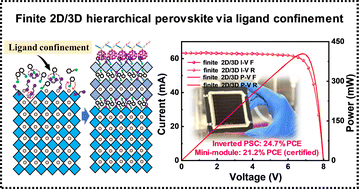Finite perovskite hierarchical structures via ligand confinement leading to efficient inverted perovskite solar cells†
Abstract
Multi-dimensional lead halide perovskite solar cells (PSCs) exhibit great promise as a next generation photovoltaic technology. Herein, we develop a unique approach via interfacial ligand confinement for constructing finite 2D/3D hierarchical perovskite structures to obtain efficient and stable inverted PSCs and modules. It is found that the introduction of a diamine masking reagent atop the 3D perovskite layer can regulate cation exchange via hydrogen bonding resulting in the formation of a finite and dense 2D layer, which is beneficial not only to accomplish top-contact passivation but also to enhance electron extraction at the electron selective contact. As a result, inverted PSCs and modules with finite 2D/3D perovskite layers achieve remarkable power conversion efficiencies (PCEs) of 24.7% and 21.6% (certified PCE of 21.2%), respectively, representing one of the best-performing inverted mini-modules reported so far. Furthermore, encapsulated PSCs are found to retain over 90% of their original PCE after 1000 hours of illumination. Overall, this work presents an effective approach for further advancing perovskite photovoltaics.



 Please wait while we load your content...
Please wait while we load your content...